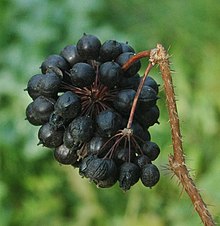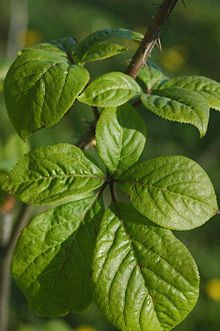| Eleutherococcus senticosus | |
|---|---|

| |
| Scientific classification | |
| Kingdom: | Plantae |
| Clade: | Tracheophytes |
| Clade: | Angiosperms |
| Clade: | Eudicots |
| Clade: | Asterids |
| Order: | Apiales |
| Family: | Araliaceae |
| Genus: | Eleutherococcus |
| Species: | E. senticosus
|
| Binomial name | |
| Eleutherococcus senticosus | |
| Synonyms[1][2] | |

Eleutherococcus senticosus is a species of small, woody shrub in the family Araliaceae native to Northeastern Asia.[1][3] It may be colloquially called devil's bush,[4] Siberian ginseng, eleuthero, ciwujia, Devil's shrub, shigoka, touch-me-not, wild pepper, or kan jang.[5] E. senticosus has a history of use in folklore and traditional Chinese medicine.[1] Root extracts of E. senticosus are sold as a dietary supplement or cosmetic, usually under the name Siberian ginseng.[3]
Etymology[edit]
The scientific name (genus), Eleutherococcus (from Greek) means "free-berried," and senticosus, (from Latin) means sentis (thorn-bush, briar), an adjective meaning "thorny" or "full of briers or thorns."[citation needed] It is not the same plant as American ginseng (Panax quinquefolius) or Asian ginseng (Panax ginseng). It has a diversity of common names across its range of distribution.[1][3]
Distribution and habitat[edit]
The herb grows in mixed and coniferous mountain forests, forming low undergrowth or is found in groups in thickets and edges. Eleutherococcus senticosus is sometimes found in oak groves at the foot of cliffs, rarely in high forest riparian woodland. Its native habitat is East Asia, China, Japan, and Russia.[1][3] E. senticosus is broadly tolerant of soils, growing in sandy, loamy, and heavy clay soils with acid, neutral, or alkaline chemistry and including soils of low nutritional value. It can tolerate sun or dappled shade and some degree of pollution. E. senticosus is a deciduous shrub growing to 2 metres (6.6 ft) at a slow rate. It is hardy to zone 3. It flowers in July in most habitats. The flowers are hermaphroditic and are pollinated by insects.[6]
Extract and chemical constituents[edit]
Roots of E. senticosus are cylindrical, up to 0.5 centimetres (0.20 in) in diameter, straight or branched, dark brown, and have a smooth surface with bark fixed closely to the xylem.[3] The derived extract from the roots has been characterized for its major constituents, including lignans, sesamin (eleutheroside B4), syringaresinol, phenylpropanes, coumarins, beta-sitosterol and daucosterol.[3]
Berries from E. senticosus contain diverse polyphenols, including caffeic acid, vanillic acid, ferulic acid, p-coumaric acid, and benzoic acid, with significant content of calcium, magnesium, and potassium.[7]
Major constituents of essential oil from leaves of Eleutherococcus senticosus include α-bisabolol (26%), β-caryophyllene (7%), germacrene D (7%), β-bisabolene (5%), and α-humulene (4%).[8]
Traditional medicine[edit]
Extracts from the root of Eleutherococcus senticosus, including eleutherosides, are promoted in alternative and traditional medicine for providing health effects, which are supported by clinical evidence.[5][9] According to the WHO, only "as a prophylactic and restorative tonic for enhancement of mental and physical capacities in cases of weakness, exhaustion and tiredness, and during convalescence" is backed up by clinical evidence.[3][10] The plant has been assessed in preliminary research for its potential use as an antimicrobial or antistress agent.[3][5]
Potential for adverse effects[edit]
People with high blood pressure, sleep apnea, narcolepsy, heart disease, mental illness, a compromised immune system, people in the processes of pregnancy and lactation, and people taking digoxin or hexobarbital may have adverse reactions to E. senticosus.[5] High doses may cause irritability, confusion, insomnia, or anxiety.[5]
References[edit]
- ^ a b c d e f "Eleutherococcus senticosus (Rupr. & Maxim.) Maxim". U.S. National Plant Germplasm System. 13 March 2017. Retrieved 30 December 2017.
- ^ "The Plant List: A Working List of All Plant Species".
- ^ a b c d e f g h "Radix Eleutherococci". Monographs on Selected Medicinal Plants, Volume 2, World Health Organization. Archived from the original on June 16, 2009. Retrieved 30 December 2017.
- ^ Lee, Sangtae; Chang, Kae Sun, eds. (2015). English Names for Korean Native Plants (PDF). Pocheon: Korea National Arboretum. p. 454. ISBN 978-89-97450-98-5. Retrieved 7 March 2019 – via Korea Forest Service.
- ^ a b c d e "Eleutherococcus". Drugs.com. 2017. Retrieved 30 December 2017.
- ^ "Eleutherococcus senticosus". Plants for a Future. Retrieved 2013-01-16.
- ^ Załuski, D; Olech, M; Galanty, A; Verpoorte, R; Kuźniewski, R; Nowak, R; Bogucka-Kocka, A (2016). "Phytochemical Content and Pharma-Nutrition Study on Eleutherococcus senticosus Fruits Intractum". Oxidative Medicine and Cellular Longevity. 2016: 9270691. doi:10.1155/2016/9270691. PMC 5098108. PMID 27843534.
- ^ Zhai, C; Wang, M; Raman, V; Rehman, J U; Meng, Y; Zhao, J; Avula, B; Wang, Y H; Tian, Z; Khan, IA (2017). "Eleutherococcus senticosus (Araliaceae) Leaf Morpho-Anatomy, Essential Oil Composition, and Its Biological Activity Against Aedes aegypti (Diptera: Culicidae)". Journal of Medical Entomology. 54 (3): 658–669. doi:10.1093/jme/tjw221. PMID 28399215. S2CID 43732277.
- ^ "Siberian ginseng". The Mount Sinai Hospital. 2022. Retrieved 4 November 2022.
- ^ Ades TB, ed. (2009). "Eleuthero". American Cancer Society Complete Guide to Complementary and Alternative Cancer Therapies (2nd ed.). American Cancer Society. pp. 337–339. ISBN 9780944235713.